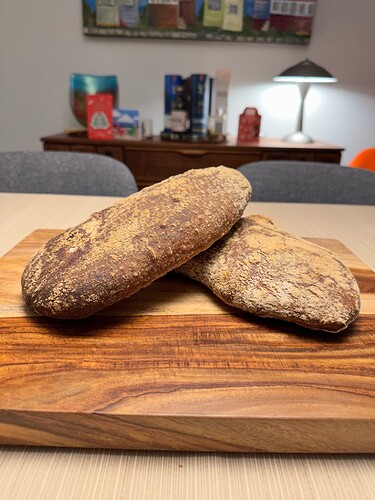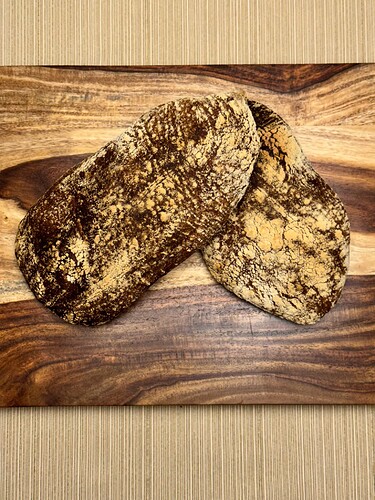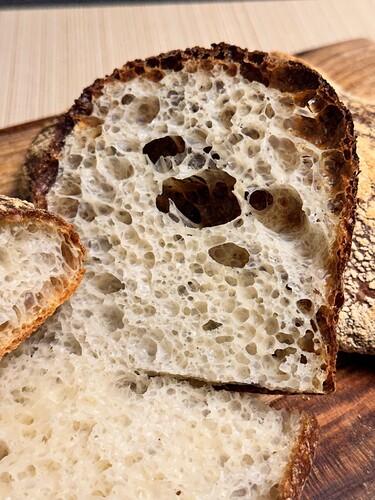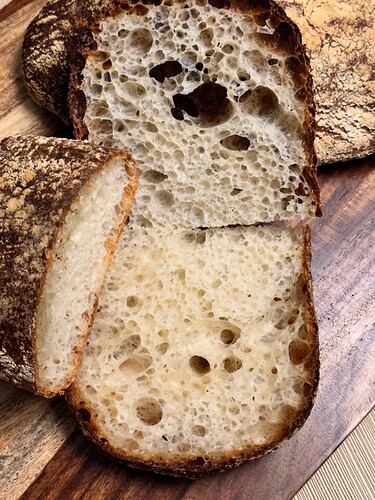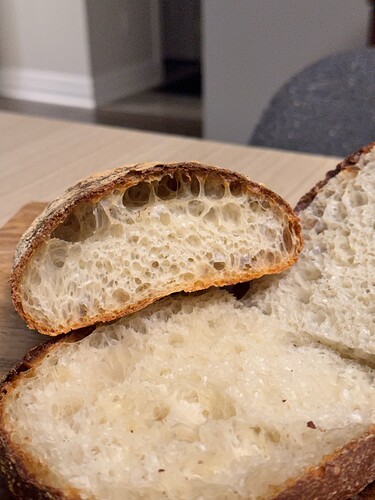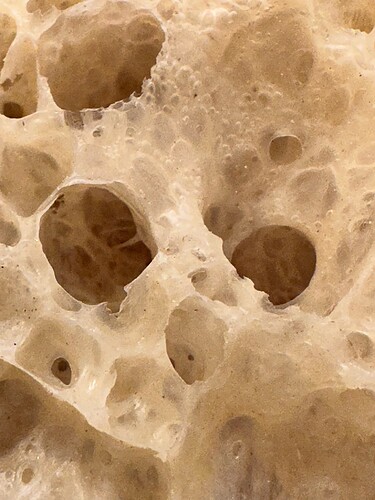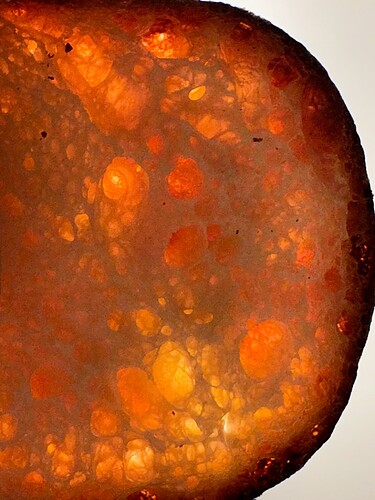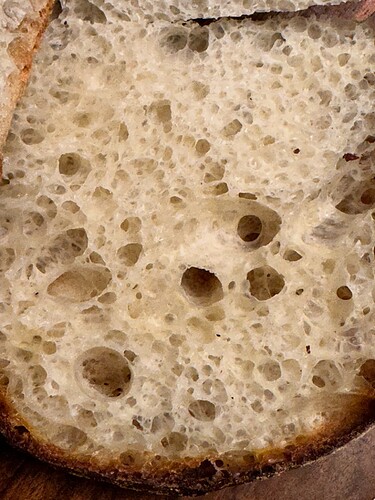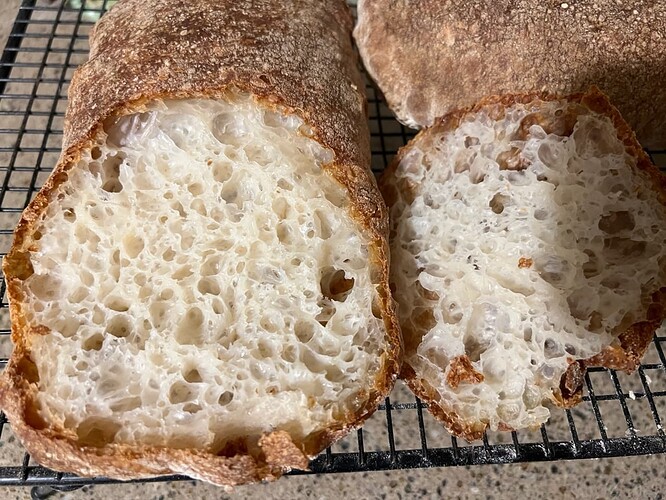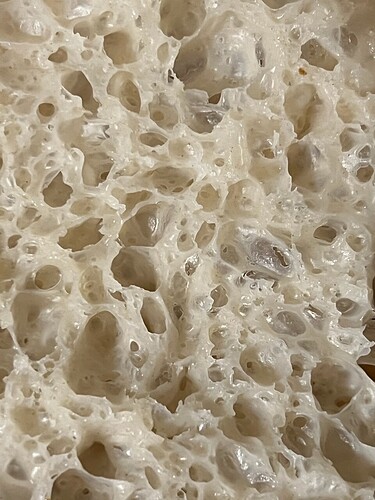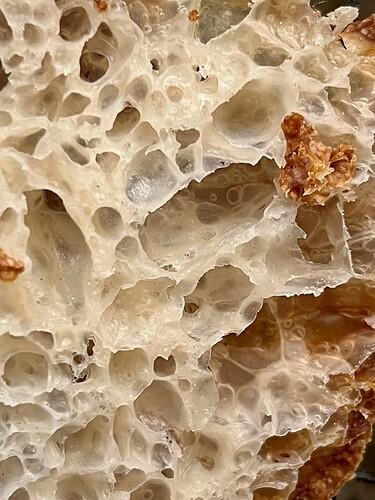Martin Philip of King Arthur recently posted a video of his pan de Cristal. I’ve always wanted to try baking this unique bread and I’m glad that I have now. I believe most recipes for this bread have some olive oil in them, so I added that. Also rather than mixing all the water at once, I bassinage the water gradually. I used my Ankarsrum Assistent to mix since I am still learning to use it and want to get as much experience as possible. It does an awesome job with bassinage. It is said to be gentle on the dough and I believe it does. I might have thought that the crumb would be tight having used a mixer to mix, however, I don’t think the crumb shows that at all. This bread has the finest crumb and a thin shattering crust. You can see why it is named Pan de Cristal, you can shine a light through the bread, even the bottom crust can show light easily through it. Each loaf feels like air, it weighs so little yet tastes so good and has such satisfying texture with the contrast of the crisp crust and soft open crumb.
For 2 medium breads
250 g water (175 g for mix) then bassinage 75 g
250 g bread flour
1.25 g IDY
5 g salt
6.26 g olive oil
Mix all flour and 175 g of water then rest 15 mins.
Dissolve 1.25 g IDY in 15 g of water add to mixer and mix until well absorbed.
Dissolve 5 g of salt in about 15 g of water and then add to the mixer until well absorbed. The addition of the salt will tighten the gluten a bit.
Bassinage the rest of the water in small aliquots waiting until the water is well absorbed before adding more.
Once all the water has been added the dough appears to be well developed, drizzle in the olive oil while the mixer is running. Mix until well incorporated, this will not take very long.
Grease a Pyrex dish with olive oil and then pour the dough into the dish. Do a few folds to get the dough into a nice roundish shape.
Place the dough in a warm place, 78°F and every 20 mins do a coil fold, stop when the dough seems to have good structure. I did three sets of coil folds.
Allow the dough to rest 2 hours.
After 2 hours the dough will have risen nicely, about double volume.
Flour the top of the dough especially around the edge of the dish. Sprinkle a generous amount of dough onto your countertop. Using a bowl scraper release the sides of the dough from the dish, then gently invert the dish so the dough releases onto the floured countertop. Generously flour the top of the dough. Using a bench scraper cut the dough carefully into two or four pieces (depends on whether you made a full or half batch). Ensure the cut edges are well floured, then gently transfer two pieces onto one piece of parchment, repeat if a full batch was made.
There is no need to cover the dough at this point, just keep it away from drafts. The development of a thin skin is actually fine and may help with the oven spring.
Allow the loaves to rest at room temperature for 2 hours, uncovered. While the loaves are resting, preheat the oven to 475°F with a baking stone or steel on a lower rack.
1 hour before final proof is complete, pre-heat your oven to 475°F with a baking stone or steel on the lowest rack. Place the other rack in the upper half of the oven.
The dough is ready to bake when it looks puffy and there are large bubbles visible in all pieces of dough on the surface.
To bake the bread: Carefully slide the two loaves (still resting on the parchment) into the oven onto the preheated stone or steel. If space is tight and the full sheet of parchment won’t fit on the stone or steel, cut the parchment between the two loaves and arrange them as best you can. Allow the other two loaves to continue to rest.
Bake the loaves for 15 minutes, then transfer them, from the stone or steel, directly onto a rack in the upper third of the oven for an additional 13 to 15 minutes. (Leave the stone in place.) Moving them to the rack allows the baking stone or steel to become hot again in preparation for the next two loaves. After a total of 27 to 30 minutes of baking, remove the loaves from the oven and allow them to cool on a rack.
Repeat the process with the two remainingloaves. Cool the bread fully before slicing.
